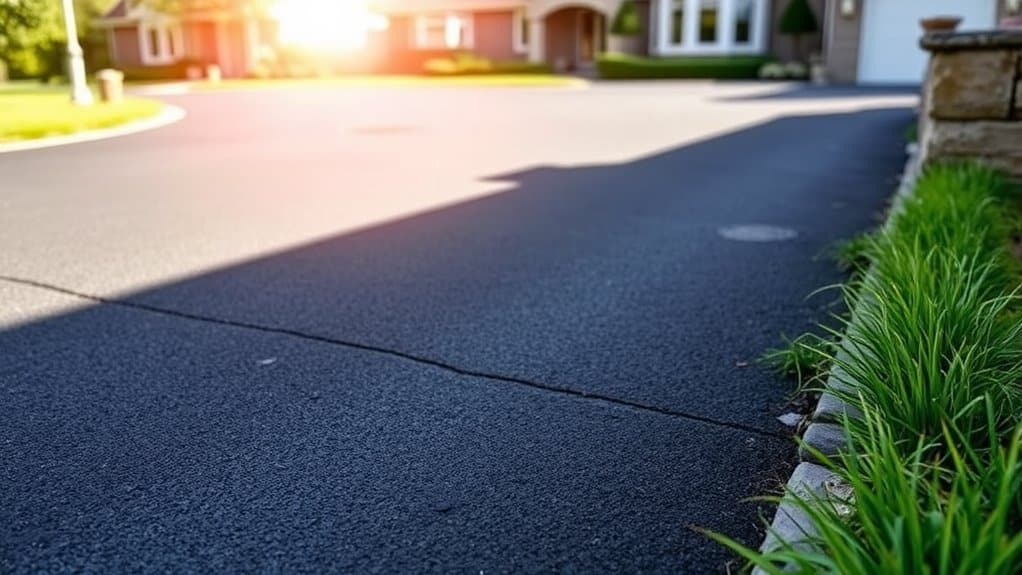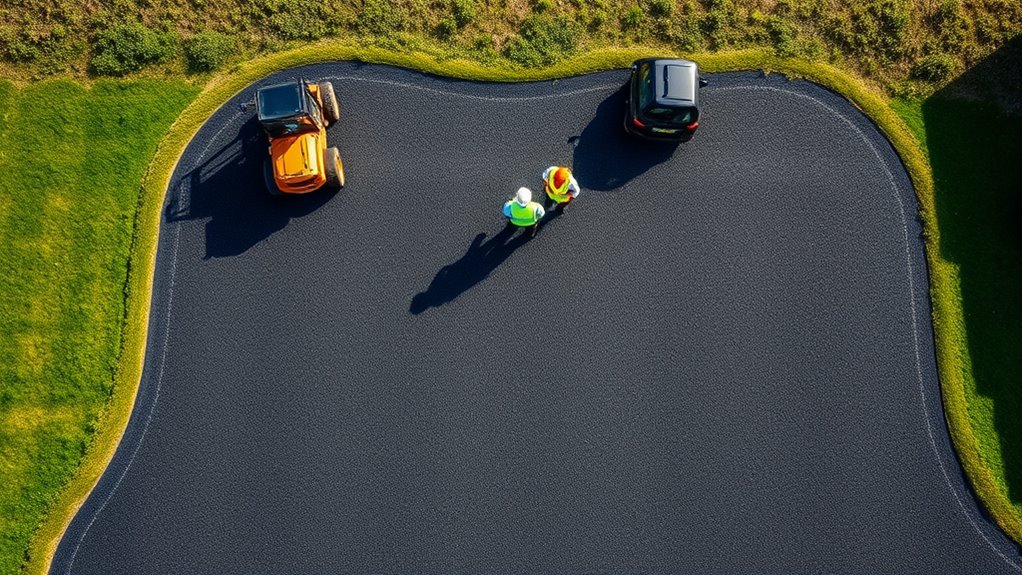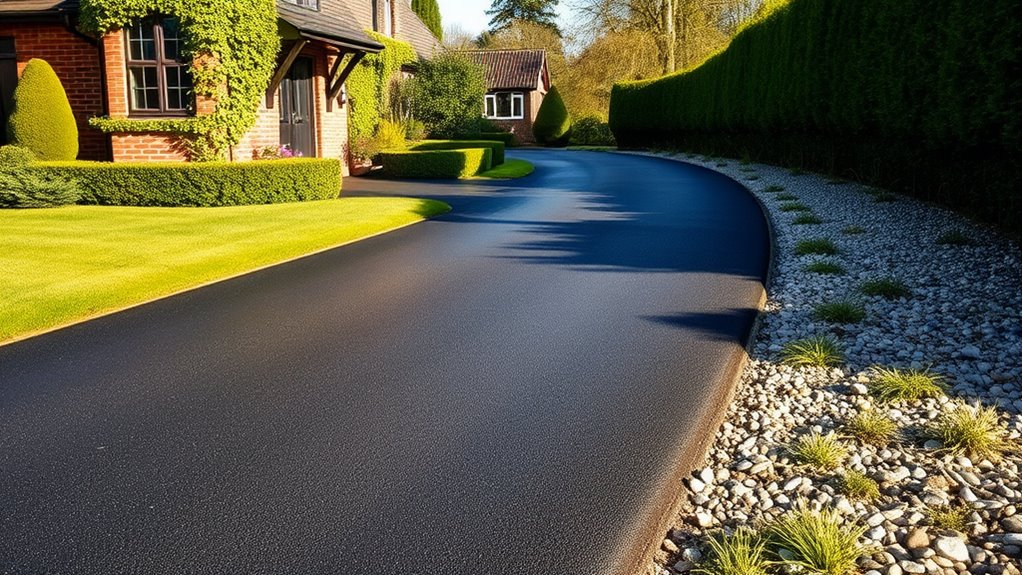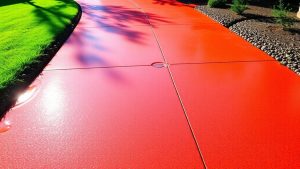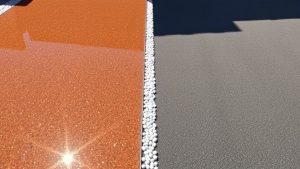Installing a tarmac driveway in the rain is not advisable. Moisture interferes with the bonding process, which can result in cracks and a weaker surface. Additionally, any moisture trapped beneath the tarmac can prolong curing times and affect the driveway’s overall durability. It’s crucial to wait for completely dry conditions before beginning installation to ensure a long-lasting finish. For more insights on ideal weather conditions and best practices for tarmac projects, keep reading.
Table of Contents
ToggleKey Takeaways
- Rain can significantly affect the bonding of tarmac, resulting in weak and uneven surfaces.
- Moisture may lead to structural issues, like cracks and potholes, which can compromise the tarmac’s integrity.
- It’s essential to ensure the ground is completely dry before continuing any paving work.
- Using specialised equipment and moisture-resistant additives can help reduce the impact of rain during installation.
- Keep an eye on the weather forecasts to adjust your installation schedule and avoid delays due to rain.
Understanding the Impact of Rain on Tarmac Installation
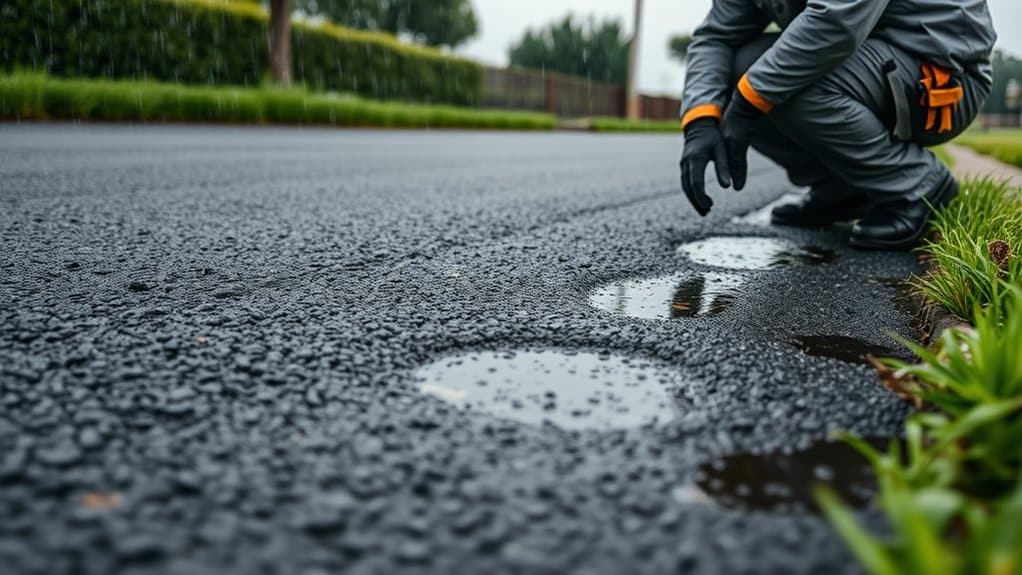
While it may seem that tarmac installation can go ahead regardless of the weather, rain has a significant impact on the process and the final result.
Water interferes with the bonding of tarmac, leading to weak and uneven surfaces. It can disrupt the setting process, causing structural damage such as cracks and potholes as moisture gets trapped. Additionally, steam can form between layers in wet conditions, compromising the integrity of the surface. Rain also causes oils to rise, which can delay curing time and affect overall quality. This is why the ground must be completely dry before paving can resume. Tarmac’s limited color choices can also become more pronounced if the installation is compromised by rain, as uneven surfaces may reflect light differently.
To ensure a durable finish, it’s crucial to avoid tarmac installation during rainy weather and to keep a close eye on conditions, as even light rain can jeopardise the outcome.
Optimal Weather Conditions for Tarmac Projects
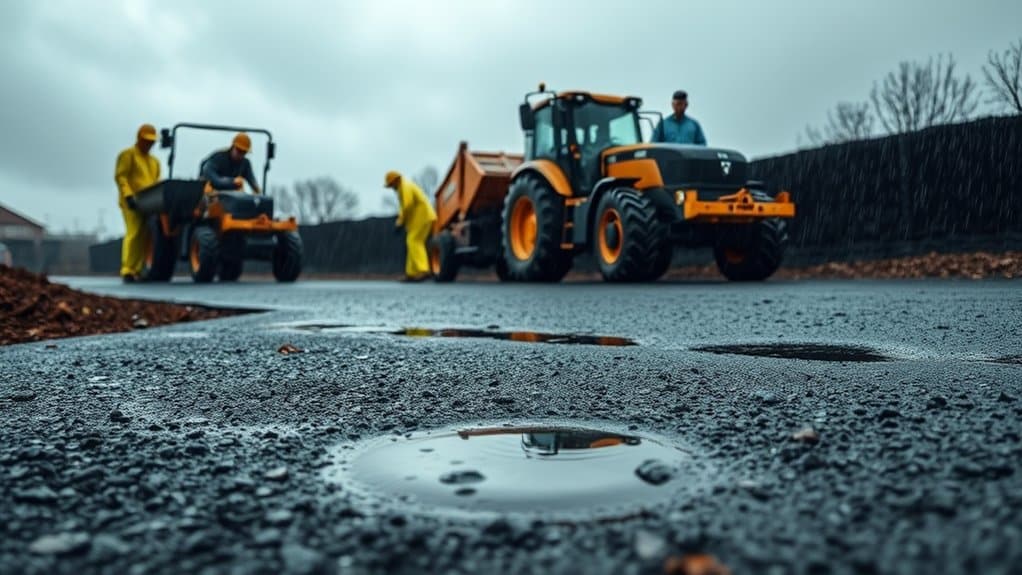
For successful tarmac installation, it’s essential to consider the weather conditions. Here are the key factors to keep in mind:
- Ambient Temperature: Aim for temperatures between 10°C and 27°C (50°F to 80°F) to ensure proper curing and compaction. Asphalt should be laid in dry and warm weather conditions for optimal results. Additionally, installing tarmac during ideal weather conditions significantly enhances durability and longevity.
- Soil Conditions: Check the soil for stability. Overly compacted or clayey soils may require treatment.
- Solar Conditions: Sunny weather helps with even heat distribution, which is beneficial for curing.
- Seasonal Timing: The best months for installation are typically from May to October, varying by region.
Effects of Moisture on Asphalt Curing
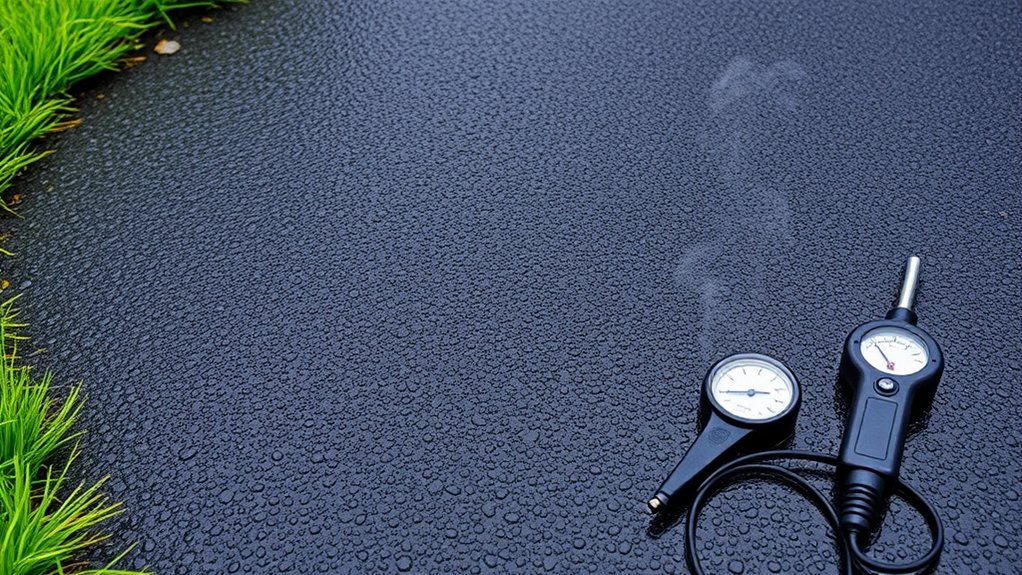
Moisture has a significant effect on the curing process of asphalt, influencing its mechanical properties and long-term performance. When moisture is present, it can create considerable challenges during curing. For instance, it may displace the asphalt film from the aggregate surface, disrupting the bond between them. This weakens the mix and can lead to issues like spontaneous emulsification.
Moreover, trapped moisture can generate pore pressure, resulting in structural problems. If moisture doesn’t evaporate completely, curing times can be extended, which may compromise the durability of the pavement. Therefore, inadequate compaction can exacerbate the effects of moisture, leading to further durability issues. It is essential to consider ideal temperature ranges when planning your tarmac project, as this directly impacts curing quality.
If you’re planning a tarmac project, it’s essential to keep in mind that moisture can lead to premature cracking, rutting, and higher maintenance costs. Therefore, ensuring dry conditions is crucial for optimal curing and performance.
Installation Techniques for Rainy Weather
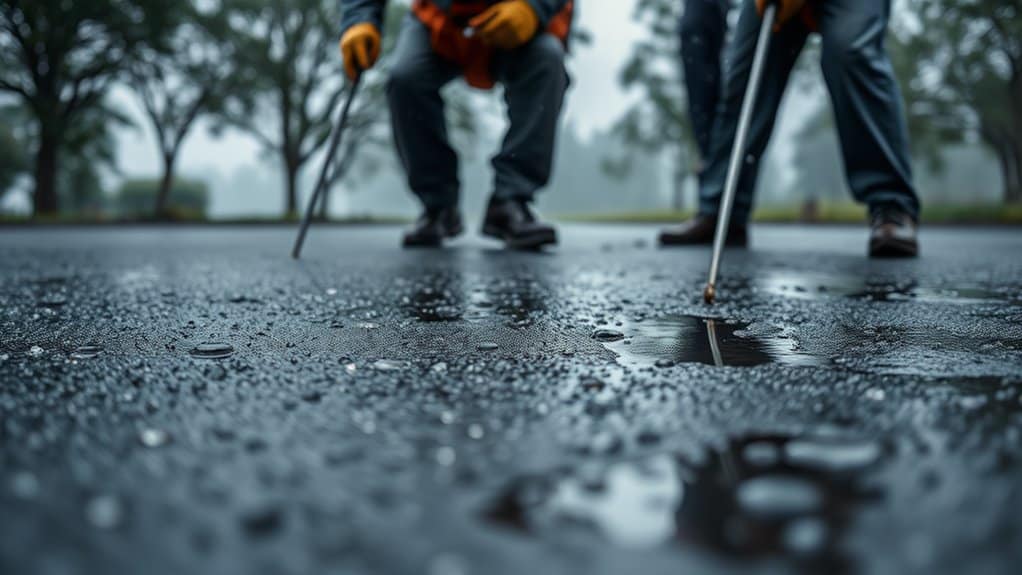
Installing a tarmac driveway in rainy weather can be challenging due to the impact of moisture on asphalt curing.
To ensure a successful installation despite the rain, follow these essential techniques:
- Carry out thorough site assessments to ensure proper drainage.
- Use specialised equipment, such as moisture-resistant mixing plants.
- Incorporate additives to improve the tarmac mix’s resistance to rain.
- Keep an eye on weather forecasts and adjust your timeline accordingly.
Maintenance Tips for New Tarmac Driveways
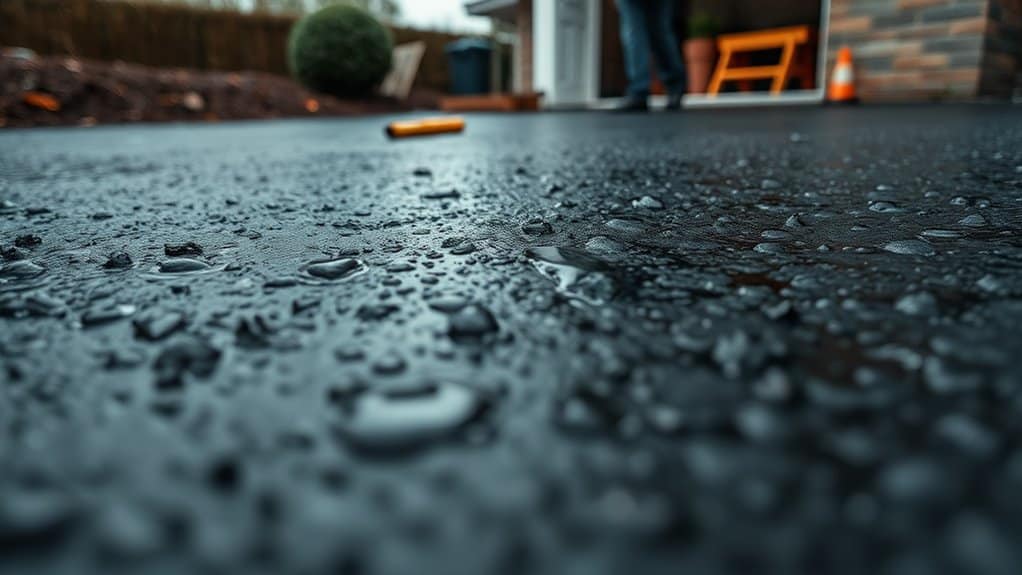
Newly installed tarmac driveways provide a robust surface, but proper upkeep is key to their longevity and functionality. Regular cleaning is vital to prevent dirt build-up and maintain their appearance. Avoid using high-pressure washers; instead, opt for mild detergents and stiff-bristled brushes to tackle stains. Act quickly on spills to avert damage. Monthly inspections help identify potential issues early, and it’s important to drain any standing water to prevent structural problems. Applying a sealant every 2-3 years boosts durability and guards against UV damage. Here are some essential maintenance tips:
| Maintenance Task | Frequency | Notes |
|---|---|---|
| Tarmac Cleaning | Monthly | Use mild cleaners |
| Driveway Sealing | Every 2-3 years | Protects against weathering |
| Inspection | Monthly | Look for cracks and stains |
| Debris Removal | Weekly | Prevents erosion |
Following these guidelines will help keep your tarmac driveway in top condition.
Scheduling Challenges Due to Rain Forecasts
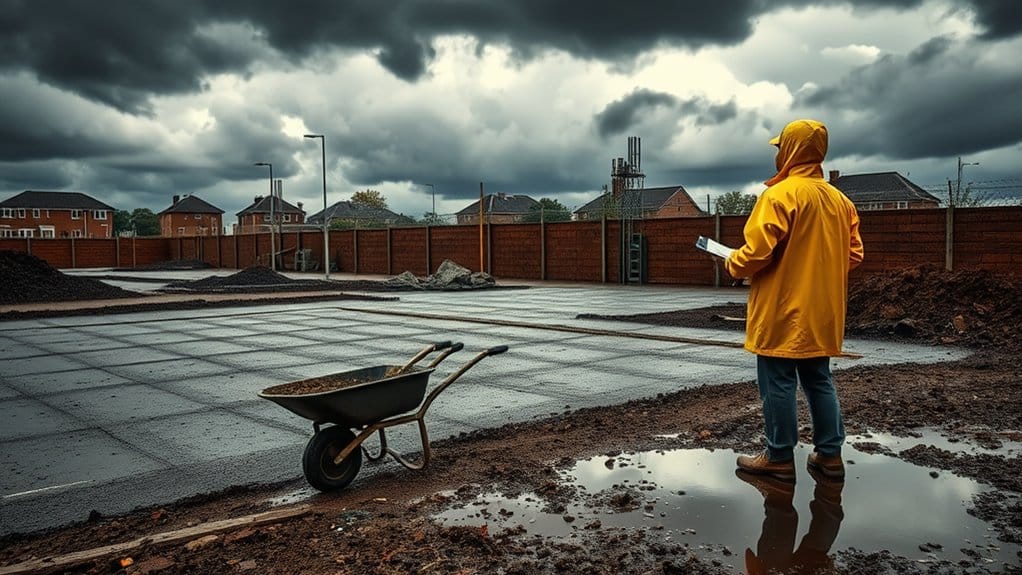
When planning a tarmac driveway installation, it’s crucial to keep an eye on rain forecasts to ensure your project stays on track and meets quality standards.
Rain can cause significant delays, so consider these points:
- Weather Updates: Regularly check local weather reports to make necessary adjustments to your schedule.
- Radar Checks: Monitor radar to assess the likelihood of rain and determine if work should proceed.
- Rain Delay Procedures: Be ready to pause work if rain is imminent.
- Clear Communication: Keep in touch with your contractors about any changes or potential delays.
Rain-related delays can set back your project and any subsequent jobs.
By understanding these scheduling challenges, you can help ensure a smooth installation as soon as the weather improves.
A dry site is essential for achieving the quality and durability you want.
Best Practices for Tarmac Durability
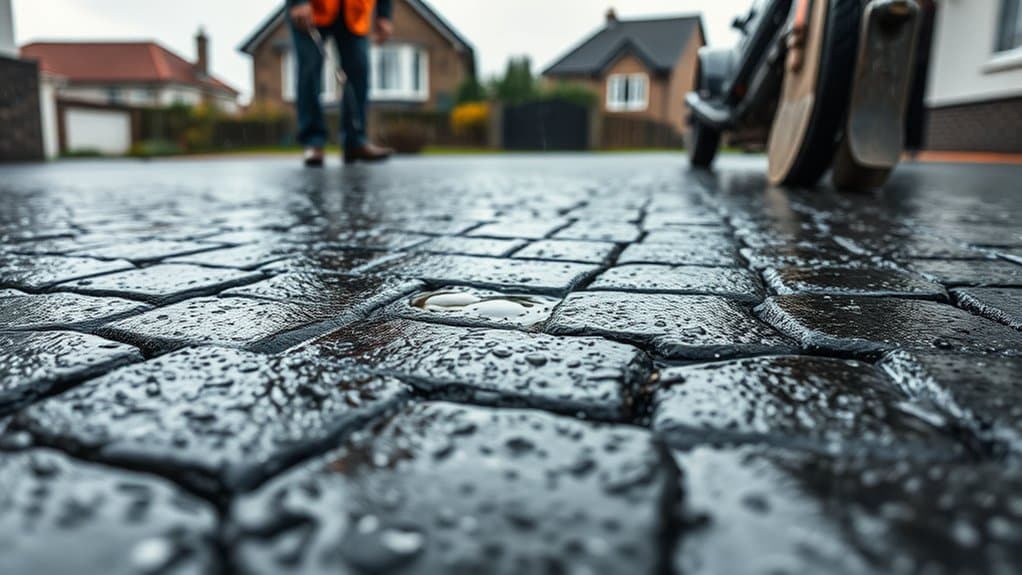
To ensure tarmac durability, install it during suitable weather conditions, as moisture can affect the binding process.
Regular maintenance, such as seal coating and quick repairs, is essential for prolonging the life of your driveway.
Ideal Weather Conditions
For the best tarmac durability, it’s essential to lay it down under ideal weather conditions. The optimal temperature range is between 10°C and 32°C.
Here are some key points to consider:
- Ambient Temperature: Aim for 20°C to 30°C to ensure the bitumen flows properly.
- Subgrade Temperature: The ground should be a minimum of 10°C to allow for effective compaction.
- Asphalt Heating: Heat the asphalt mix to between 105°C and 145°C to enhance its durability.
- Rain Considerations: Avoid installing tarmac during rain, as this can negatively impact the quality by affecting compaction and adhesion.
Paying attention to these conditions will significantly improve the lifespan and performance of your tarmac driveway.
Regular Surface Maintenance
Proper maintenance of your tarmac driveway is crucial for its longevity and performance, particularly after considering the best weather conditions for installation.
Start with regular cleaning—sweep away leaves and debris, then rinse with low-pressure water. For stains, a mild detergent solution and a stiff-bristled brush will do the trick. It’s important to act quickly on spills to prevent stains; clean them immediately with suitable products.
Avoid parking heavy vehicles or turning wheels while stationary, as this can cause damage.
Sealcoating every 3 to 5 years protects against UV rays and chemicals, improving appearance and preventing stains.
Regular inspections will help you spot and address cracks or potholes promptly, ensuring your driveway remains in great condition.
The Role of Temperature and Humidity
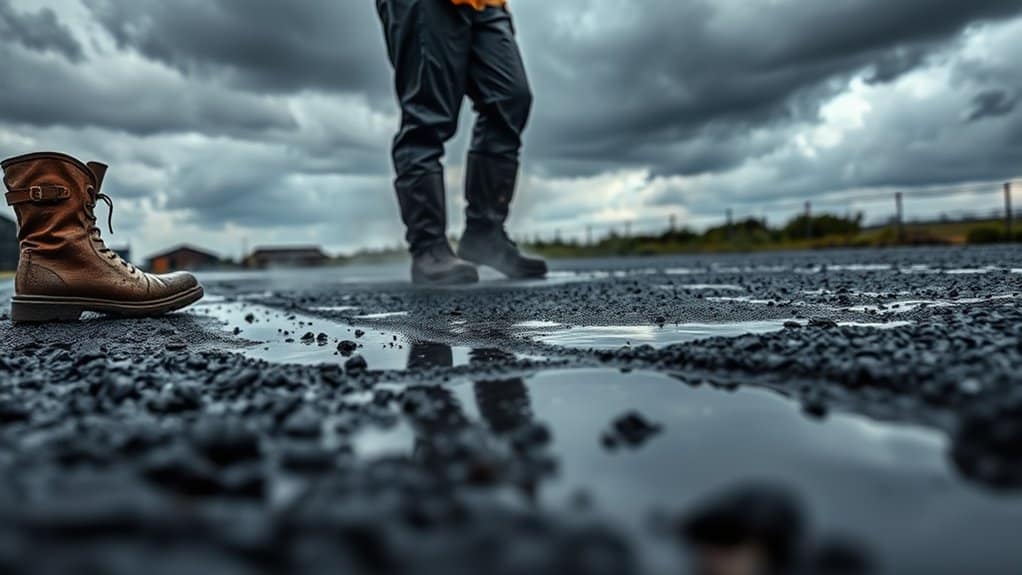
When installing a tarmac driveway, it’s crucial to maintain the right temperature for optimal results.
High humidity can significantly impact the curing process, which may cause delays and weaken the surface. Knowing how temperature and humidity affect asphalt is key to ensuring a robust and long-lasting driveway.
For instance, if it’s too humid on the day of installation, it could lead to a softer surface that’s prone to damage.
Ideal Temperature Range
Achieving the ideal temperature range is crucial for a successful tarmac driveway installation. Several factors can affect asphalt performance during the process.
To ensure proper compaction and adhesion, keep these points in mind:
- The optimal temperature for laying tarmac is between 20°C and 30°C.
- Temperatures dropping below 10°C can impede binding, increasing the risk of raveling.
- Excessive heat above 32°C may cause rutting and softening of the asphalt.
- Ensure the subgrade temperature is at least 10°C to avoid rapid cooling.
Maintaining effective temperature control during installation is vital for preserving the heat in the asphalt mix, which enhances compaction and durability.
Humidity Impact on Curing
Humidity significantly affects the curing process of tarmac, making installation more challenging. High humidity slows down moisture evaporation, which is crucial for forming a strong bond. Elevated humidity can compromise adhesion and compaction, resulting in weak and uneven surfaces.
To manage this, it’s essential to measure humidity accurately during installation. Improving air circulation around the area and employing specialised curing techniques can help speed up drying.
Additionally, keeping an eye on weather forecasts allows you to schedule your work during drier periods, leading to a more successful tarmac installation. By effectively managing humidity, you can enhance the durability and performance of your tarmac driveway.
Weather Sensitivity of Asphalt
Understanding how weather affects asphalt is essential for a successful installation. Temperature and humidity play a significant role in asphalt viscosity and performance. Here are some important points to consider:
- Ideal Temperatures: For the best application, ambient temperatures should be between 10°C and 32°C.
- Mix Temperature: Keep the asphalt mixture between 140°C and 177°C during processing.
- Ground Temperature: Ensure ground temperatures are above 10°C to prevent water accumulation.
- Maximum Heat: Avoid exceeding 48°C to ensure proper compaction.
These factors can lead to challenges in compaction and impact the durability of your pavement.
Choosing the Right Asphalt Mix for Weather Conditions
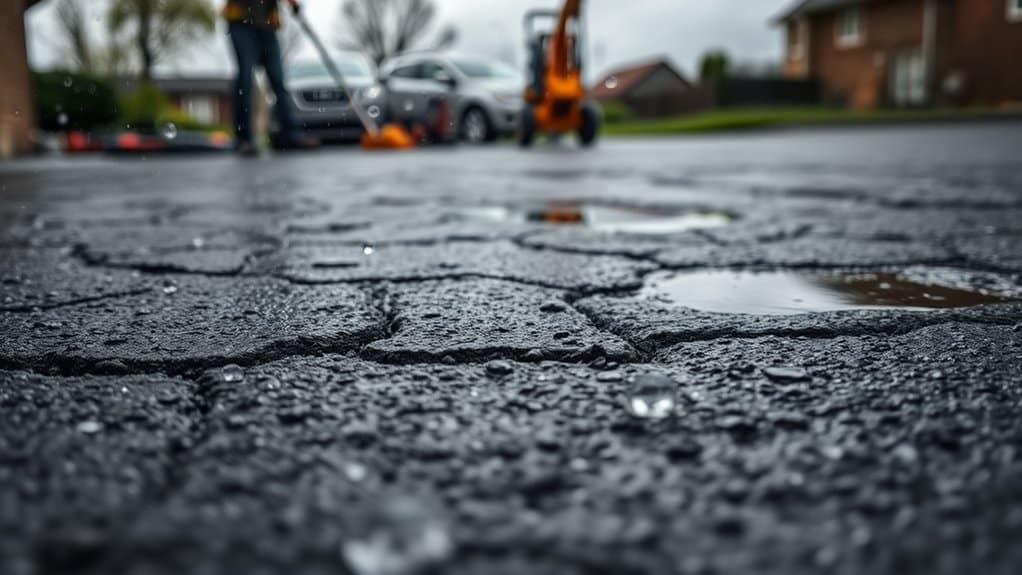
When choosing the right asphalt mix for rainy weather, it’s important to consider how various types react to moisture. Here’s a brief comparison:
| Asphalt Mix Type | Suitable for Rainy Conditions | Key Properties |
|---|---|---|
| Hot Mix Asphalt | No | High temperature, durable |
| Warm Mix Asphalt | Yes | Lower temperature, versatile |
| Cold Mix Asphalt | Yes | Temporary, moisture resistant |
| Dense-Graded Mix | No | High traffic, less ideal |
| Porous Asphalt | No | Drainage-focused |
For wet conditions, warm or cold mix asphalt is often the best choice, as they can help ensure your driveway lasts longer and performs better.
Effective Communication With Contractors During Rainy Seasons
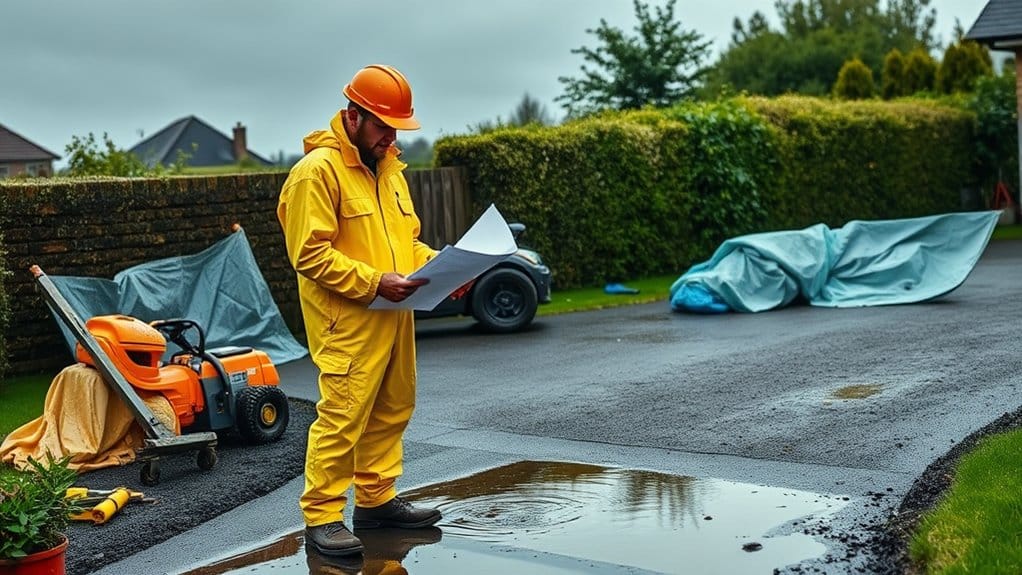
Choosing the right asphalt mix is just one aspect of planning a tarmac driveway installation.
Clear communication with your contractors during rainy seasons is crucial. Here are four strategies to improve collaboration:
- Hold regular project meetings to review progress and discuss any weather-related changes.
- Use digital project management tools for instant updates and progress tracking.
- Ensure all parties are kept informed about schedule alterations and the reasons behind them.
- Maintain transparency to manage expectations and foster trust.
Frequently Asked Questions
What Are the Signs of Poor Tarmac Installation?
Signs of poor tarmac installation include uneven surfaces, cracks, and poor drainage. Check the quality of the tarmac and the methods used for installation; these directly impact the longevity and performance of your driveway. For instance, if you notice water pooling in certain areas, it may indicate inadequate drainage, which can lead to further issues down the line. Keep an eye out for these signs to ensure your driveway lasts.
Can I Drive on New Tarmac if It Rains?
Driving on new tarmac in heavy rain is not advisable; it can damage the tarmac and affect its durability. Rain can interfere with the curing process, leading to uneven surfaces. It’s best to wait at least 48 hours after the rain before driving on new tarmac to ensure it has stabilised properly.
How Long Should I Wait to Seal a New Tarmac Driveway?
You should wait 30 to 90 days after installing a new tarmac driveway before sealing it. This allows adequate time for curing. To ensure a long-lasting finish, make sure the surface is clean and dry before applying the sealant.
Will Rain Affect the Appearance of My Tarmac Driveway?
Rain can significantly impact the appearance and durability of your tarmac driveway. Moisture can weaken the bonds within the tarmac, leading to cracks and surface erosion, which affects both its looks and structural strength. For instance, you might notice unsightly water pooling or discolouration after heavy rain. Regular maintenance, such as sealing and filling cracks, can help prevent these issues and keep your driveway looking its best.
What Is the Cost Impact of Rescheduling Due to Rain?
Rescheduling due to rain can result in notable costs, such as higher labour expenses and possible material wastage. For example, if a construction crew has to halt work, you might end up paying them for idle time, which can quickly add up. Furthermore, delays can disrupt project timelines, potentially affecting your financial arrangements and exposing you to the risk of inflation. It’s essential to factor in these costs when planning outdoor activities or projects.
Conclusion
When it comes to installing a tarmac driveway, rain can pose a significant challenge. While you might be tempted to go ahead with the work during a light shower, it’s crucial to consider how moisture affects the asphalt. For the best results, aim for dry weather; think of it like planting seeds in good soil to ensure they thrive.
Always communicate with your contractor about the weather conditions. This will help ensure that your driveway is built to last, able to withstand whatever the British weather throws at it. By taking these factors into account, you’ll set the stage for a durable and resilient driveway.
Just how long can you expect your tarmac driveway to last? Discover key factors and maintenance tips that can extend Read more
From planning to final touches, discover the essential steps of tarmac driveway installation—what could go wrong if you skip any Read more
Wondering if a tarmac driveway is the perfect fit for your home? Uncover the essential pros and cons before making Read more


